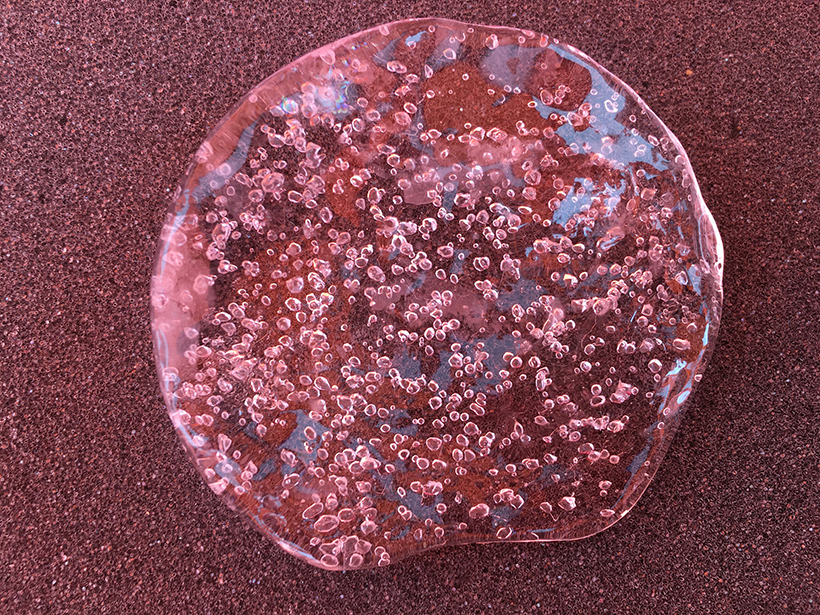To determine how Earth’s climate has varied over time, scientists are constantly on the lookout for the oldest whiffs of our planet’s atmosphere. The current record holders, recently extracted from Antarctic ice cores and dated to over 2 million years old, reveal concentrations of gases like carbon dioxide (CO2) and methane in ancient Earth’s atmosphere.
Researchers have now shown that levels of these greenhouse gases fluctuated less millions of years ago than they did in more recent times. That discovery has implications for how Earth transitioned between two climatic periods roughly a million years ago, the team reported.
Two Worlds
The climatic history of Earth has been far from constant: For the past 800,000 years, continental-scale ice sheets have repeatedly grown and retreated in glacial-interglacial cycles occurring roughly every 100,000 years (the “100K world”). (The current interglacial period, which has persisted for about the past 11,000 years, is known as the Holocene.)
But records stretching back further in time—to between 2.8 million and 1.2 million years ago—suggest that glacial-interglacial cycles were shorter and lasted only about 40,000 years (the “40K world”). However, there have been no direct observations of atmospheric greenhouse gases from that long ago. Until now.
Yuzhen Yan, a geoscientist at Princeton University when this research was conducted, and his collaborators spent 7 weeks in Antarctica during the 2015–2016 austral summer collecting ice cores. They worked in the Allan Hills, about 200 kilometers northwest of McMurdo Station. The area, famous for its ice, is also a mecca for meteorite hunters: ALH84001, a potato-sized meteorite originally blasted off of Mars, was found in the Allan Hills and made headlines in the 1990s when scientists announced that it contained microbial fossils.
Follow the Blue
“What used to be buried very deep…is progressively getting closer to the surface.”
Yan and his colleagues drilled into “blue ice,” a rare type of ice that’s been compressed over time. Scientists value it because it’s often very old, even when relatively near the surface. In the Allan Hills, blue ice is being pushed toward a mountain and is slowly uplifting, Yan said. “What used to be buried very deep…is progressively getting closer to the surface.” At the same time, strong winds ablate the ice from the top, progressively removing younger material.
Working in temperatures of around –15°C, the researchers drilled down to nearly bedrock and extracted roughly 300 meters of ice from three sites. Back in the laboratory, they age dated sections of the 8-centimeter-diameter (3-inch) ice cores using argon isotopes.
However, the ages they recovered didn’t march smoothly from youngest to oldest—there were discontinuities, probably caused by the ice folding as it uplifted, the team suggests. Dating blue ice is a “key difficulty” in ice core analysis, given its jumbled stratigraphy, said John Moore, a climate scientist at the University of Lapland and Beijing Normal University not involved in the research. But there’s still “huge potential” to studying blue ice, he said.
Pesky Microbes
Given the discontinuous ages of the cores they recovered, Yan and his colleagues interpreted their measurements as “snapshots” of the ancient climate rather than a continuous record. They divided their 40K-world samples into three bins with average ages of 1.5 million, 2.0 million, and 2.7 million years. However, it wasn’t possible to accurately measure the concentration of carbon dioxide in air bubbles from the oldest ice.
Blame the microbes, the team concluded. Millions of years ago, tiny organisms were probably consuming organic matter near the ice-bedrock interface and emitting carbon dioxide. The tip-off? A carbon dioxide concentration of over 1,600 parts per million in the oldest ice, roughly fourfold higher than present-day levels. “That’s very high,” said Yan.
Younger ice—farther away from the ice-bedrock interface—wasn’t as affected by contributions of this “respiratory CO2,” the scientists concluded. After correcting for their discrete sampling, Yan and his collaborators estimated that carbon dioxide concentrations in the 40K world ranged from 204 to 289 parts per million.
By comparing these data with those from other ice core records, researchers concluded that carbon dioxide levels were similar in the 40K and 100K worlds during interglacial periods. However, the picture changed during glacial periods: Carbon dioxide levels were about 20 parts per million higher, on average, in the 40K world compared with the 100K world. That’s consistent with a number of other proxy reconstructions, said Yan, but now “we can tell this with a very high level of confidence.”
Dust Fertilization?
“This time, they’re bringing a 10-inch drill.”
These results contradict the idea that a long-term decline in carbon dioxide levels during both glacial and interglacial periods drove the transition between the 40K and 100K worlds, the researchers suggest. “We’re against the notion that long-term cooling was the cause of the Mid-Pleistocene Transition,” said Yan.
Instead, these data are consistent with another hypothesis involving airborne dust. The concept is that winds deposited dust containing iron and other micronutrients near Antarctica around 800,000 years ago. This “fertilization” of the Southern Ocean boosted biological productivity because marine organisms such as phytoplankton rely on iron for growth. As these organisms died, their carbon-rich shells and skeletons sank to the seafloor and were incorporated, over millions of years, into rocks like limestone. This drawdown of carbon lowered atmospheric carbon dioxide levels during glacial periods, researchers have hypothesized.
Getting even older samples of ice will allow scientists to dig further back into Earth’s climate history, said Yan. Right now, several of his colleagues are back in Antarctica, drilling again in the Allan Hills. And they’ve got the really big equipment with them, said Yan. “This time, they’re bringing a 10-inch drill.”
Full results were published last month in Nature.
—Katherine Kornei (@katherinekornei), Science Writer
Citation:
Kornei, K. (2019), Antarctic ice cores offer a whiff of Earth’s ancient atmosphere, Eos, 100, https://doi.org/10.1029/2019EO136975. Published on 27 November 2019.
Text © 2019. The authors. CC BY-NC-ND 3.0
Except where otherwise noted, images are subject to copyright. Any reuse without express permission from the copyright owner is prohibited.

